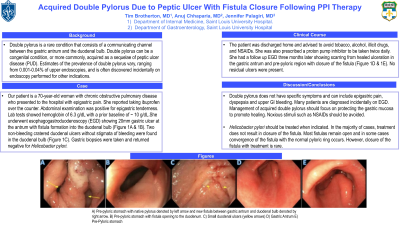Back


Poster Session E - Tuesday Afternoon
Category: Stomach
E0715 - Acquired Double Pylorus Due to Peptic Ulcer With Fistula Closure Following PPI Therapy
Tuesday, October 25, 2022
3:00 PM – 5:00 PM ET
Location: Crown Ballroom

Has Audio
- TB
Tim Brotherton, MD
Saint Louis University
St. Louis, Missouri
Presenting Author(s)
Tim Brotherton, MD, Anuj Chhaparia, MD, Jennifer Palagiri, MD
Saint Louis University, St. Louis, MO
Introduction: Double pylorus is a rare condition that consists of a communicating channel between the gastric antrum and the duodenal bulb. Double pylorus can be a congenital condition, or more commonly, acquired as a sequelae of peptic ulcer disease (PUD). Estimates of the prevalence of double pylorus vary, ranging from 0.001-0.04% of upper endoscopies, and is often discovered incidentally on endoscopy performed for other indications.
Case Description/Methods: Our patient is a 70-year-old woman with chronic obstructive pulmonary disease who presented to the hospital with epigastric pain. She reported taking ibuprofen over the counter. Abdominal examination was positive for epigastric tenderness. Lab tests showed hemoglobin of 6.3 g/dL with a prior baseline of ~ 10 g/dL.
She underwent esophagogastroduodenoscopy (EGD) showing 20mm gastric ulcer at the antrum with fistula formation into the duodenal bulb (Figure 1A & 1B). Two non-bleeding cratered duodenal ulcers without stigmata of bleeding were found in the duodenal bulb (Figure 1C). Gastric biopsies were taken and returned negative for Helicobacter pylori.
The patient was discharged home and advised to avoid tobacco, alcohol, illicit drugs, and NSAIDs. She was also prescribed a proton pump inhibitor to be taken twice daily. She had a follow up EGD three months later showing scarring from healed ulceration in the gastric antrum and pre-pyloric region with closure of the fistula (Figure 1D & 1E). No residual ulcers were present.
Discussion: Acquired double pylorus is associated with Helicobacter pylori infection as well as ingestion of NSAIDs. These exposures are known to predispose patients to development of gastric ulcers, which when penetrating, can result in fistula formation. Interestingly, chronic obstructive pulmonary disease (present in our patient) is also a recognized risk factor.
Double pylorus does not have specific symptoms and can include epigastric pain, dyspepsia and upper GI bleeding. Many patients are diagnosed incidentally on EGD. Management of acquired double pylorus should focus on protecting the gastric mucosa to promote healing. Noxious stimuli such as NSAIDs should be avoided. Helicobacterpylori should be treated when indicated. In the majority of cases, treatment does not result in closure of the fistula. Most fistulas remain open and in some cases convergence of the fistula with the normal pyloric ring occurs. However, closure of the fistula with treatment is rare.

Disclosures:
Tim Brotherton, MD, Anuj Chhaparia, MD, Jennifer Palagiri, MD. E0715 - Acquired Double Pylorus Due to Peptic Ulcer With Fistula Closure Following PPI Therapy, ACG 2022 Annual Scientific Meeting Abstracts. Charlotte, NC: American College of Gastroenterology.
Saint Louis University, St. Louis, MO
Introduction: Double pylorus is a rare condition that consists of a communicating channel between the gastric antrum and the duodenal bulb. Double pylorus can be a congenital condition, or more commonly, acquired as a sequelae of peptic ulcer disease (PUD). Estimates of the prevalence of double pylorus vary, ranging from 0.001-0.04% of upper endoscopies, and is often discovered incidentally on endoscopy performed for other indications.
Case Description/Methods: Our patient is a 70-year-old woman with chronic obstructive pulmonary disease who presented to the hospital with epigastric pain. She reported taking ibuprofen over the counter. Abdominal examination was positive for epigastric tenderness. Lab tests showed hemoglobin of 6.3 g/dL with a prior baseline of ~ 10 g/dL.
She underwent esophagogastroduodenoscopy (EGD) showing 20mm gastric ulcer at the antrum with fistula formation into the duodenal bulb (Figure 1A & 1B). Two non-bleeding cratered duodenal ulcers without stigmata of bleeding were found in the duodenal bulb (Figure 1C). Gastric biopsies were taken and returned negative for Helicobacter pylori.
The patient was discharged home and advised to avoid tobacco, alcohol, illicit drugs, and NSAIDs. She was also prescribed a proton pump inhibitor to be taken twice daily. She had a follow up EGD three months later showing scarring from healed ulceration in the gastric antrum and pre-pyloric region with closure of the fistula (Figure 1D & 1E). No residual ulcers were present.
Discussion: Acquired double pylorus is associated with Helicobacter pylori infection as well as ingestion of NSAIDs. These exposures are known to predispose patients to development of gastric ulcers, which when penetrating, can result in fistula formation. Interestingly, chronic obstructive pulmonary disease (present in our patient) is also a recognized risk factor.
Double pylorus does not have specific symptoms and can include epigastric pain, dyspepsia and upper GI bleeding. Many patients are diagnosed incidentally on EGD. Management of acquired double pylorus should focus on protecting the gastric mucosa to promote healing. Noxious stimuli such as NSAIDs should be avoided. Helicobacterpylori should be treated when indicated. In the majority of cases, treatment does not result in closure of the fistula. Most fistulas remain open and in some cases convergence of the fistula with the normal pyloric ring occurs. However, closure of the fistula with treatment is rare.

Figure: A) Pre-pylori stomach with native pylorus denoted by left arrow and new fistula between gastric antrum and duodenal bulb denoted by right arrow.
B) Pre-pyloric stomach with fistula opening to the duodenum.
C) Small duodenal ulcers (yellow arrows)
D) Gastric Antrum
E) Pre-Pyloric stomach
B) Pre-pyloric stomach with fistula opening to the duodenum.
C) Small duodenal ulcers (yellow arrows)
D) Gastric Antrum
E) Pre-Pyloric stomach
Disclosures:
Tim Brotherton indicated no relevant financial relationships.
Anuj Chhaparia indicated no relevant financial relationships.
Jennifer Palagiri indicated no relevant financial relationships.
Tim Brotherton, MD, Anuj Chhaparia, MD, Jennifer Palagiri, MD. E0715 - Acquired Double Pylorus Due to Peptic Ulcer With Fistula Closure Following PPI Therapy, ACG 2022 Annual Scientific Meeting Abstracts. Charlotte, NC: American College of Gastroenterology.
